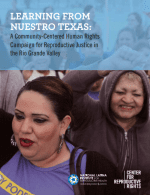Learning from Nuestro Texas: A Community-Centered Human Rights Campaign for Reproductive Justice in the Rio Grande Valley

In 2011, the Texas legislature slashed the state’s family planning budget by two-thirds and restricted providers’ ability to participate in low-cost women’s health services. In combination with federal health care and immigration policies, this move created additional, and often insurmountable, barriers to reproductive health care—care that the United Nations defines as a universal human right—for low-income Latina immigrants living in the Texas Rio Grande Valley.
In response to the alarming and deteriorating conditions facing women in the Valley, the Center for Reproductive Rights (the Center) and the National Latina Institute for Reproductive Health (NLIRH) collaborated with Latina activists of NLIRH’s Texas Latina Advocacy Network (TX LAN) in the Rio Grande Valley to launch a campaign that would integrate international human rights language and accountability mechanisms into a locally led movement for reproductive health care access. Known as Nuestro Texas (Our Texas), the campaign ran from early 2013 through May 2016. The campaign’s purpose was to bring visibility to individuals most impacted by state and federal policies that placed significant barriers in the way of low-income immigrant women’s ability to access reproductive health care.
Important impacts resulting from the Nuestro Texas campaign include:
- An increase in activists’ self-concept as agents of change and their capacity for leadership, community mobilization, and advocacy
- International awareness of, and responses to, human rights violations not commonly thought to exist in the United States
- An increased ability among policymakers, organizational allies, and the media to see and communicate about the interconnected human rights violations experienced by those living in the Valley
The purpose of this case study is to highlight the value of using the human rights framework in a domestic grassroots social justice campaign, articulate some of the lessons and questions that arose along the way, share the success of the campaign’s strategies with other progressive social justice and human rights organizations, and inspire new examples of human rights-based organizing and advocacy.
